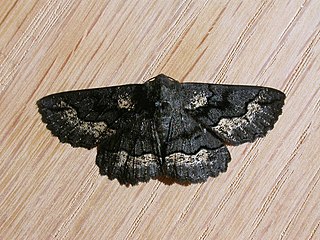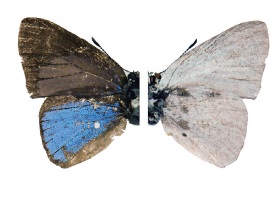Geitoneura klugii, the common xenica or Klug's xenica, is a species of butterfly belonging to the family Nymphalidae. It is a southern Australian butterfly that is easily camouflaged because of its resemblance to the ground where it is usually found fluttering. It has a wingspan of about 38 millimetres (1.5 in). The upper and lower side of the forewing is black with brownish-black markings and contains a black spot with a white centre. The orange hindwing is set off by a black border and a black-rimmed eyespot. The underside of the hindwing ranges from grey to brown and consists of darker markings.

Lithosia quadra, the four-spotted footman, is a moth of the family Erebidae. It is found in southern and central Europe then east across the Palearctic to the Amur River and Japan. It is also found in the south of Great Britain and Scandinavia.

Cephonodes hylas, the coffee bee hawkmoth, pellucid hawk moth or coffee clearwing, is a moth of the family Sphingidae. The species was first described by Carl Linnaeus in 1771. A widely distributed moth, it is found in the Near East, Middle East, Africa, India, Sri Lanka, Japan, Southeast Asia and Australia.

Colias philodice, the common sulphur or clouded sulphur, is a North American butterfly in the family Pieridae, subfamily Coliadinae.

Calliteara pudibunda is a moth of the family Erebidae. It is found in Europe, Anatolia, Caucasus, West Siberia, Eastern Transbaikalia and Amur basin in SE Russia, Korea, China and Northern Vietnam.

Enargia paleacea, the angle-striped sallow, is a moth of the family Noctuidae. It is found in the Palearctic ecozone from Ireland to Siberia East to Japan.

The Barred Sallow(Tiliacea aurago) is a moth of the family Noctuidae. It is found in Europe.

Melanodes is a monotypic moth genus in the family Geometridae. Its only species, Melanodes anthracitaria, the black geometrid, is found in Australia, more specifically in southern Queensland, New South Wales, Victoria, South Australia, and Tasmania. The genus and species were described by Achille Guenée in 1857.

Thyas coronata is a species of moth of the family Noctuidae first described by Johan Christian Fabricius in 1775. It is found from the Indo-Australian tropics of India, Sri Lanka to Micronesia and the Society Islands.

Eudocima homaena is a moth of the family Erebidae first described by Jacob Hübner in 1816. It is found in the Indian subregion, Sri Lanka, Taiwan, the Nicobars, Peninsular Malaysia, Borneo, the Philippines and on Christmas Island. It is a major pest on orange plants.

Euphydryas cynthia, or Cynthia's fritillary, is a butterfly of the family Nymphalidae. It is found in the Alps and in mountainous areas of Bulgaria in alpine meadows from 400 to 2,300 meters.

The silky hairstreak, also known as the chlorinda hairstreak, is a butterfly belonging to the family Lycaenidae. It occurs in Australia. It is the only species in the monotypic genus Pseudalmenus.

Acraea cabira, the yellow-banded acraea, is a butterfly of the family Nymphalidae that is native to Africa.

Paradarisa consonaria, the brindled square spot or square spot, is a moth of the family Geometridae. It is found in north and central Europe and east to south-eastern Siberia and Japan.

Anestia ombrophanes, the clouded footman, is a moth of the subfamily Arctiinae. The species was first described by Edward Meyrick in 1886. It is known from the Australian Capital Territory, New South Wales, Queensland, Western Australia and Victoria.

Nacaduba biocellata, the double-spotted line blue, is a butterfly of the family Lycaenidae. It is found in Australia, Singapore, the New Hebrides, Sumba and Bali.
Thyrassia inconcinna is a species of moth in the family Zygaenidae. It is found in Queensland, Australia.

Calliteara lunulata is a moth of the family Erebidae. It is found in the Russian Far East, Japan, China and Taiwan.

Philiris fulgens, the purple moonbeam, is a species of butterfly of the family Lycaenidae. It is found in Indonesia, New Guinea and Australia.
Callizyga dispar is a moth in the family Depressariidae, and the only species in the genus Callizyga. It was described by Turner in 1894 and is found in Australia, where it has been recorded from Queensland and New South Wales.

















